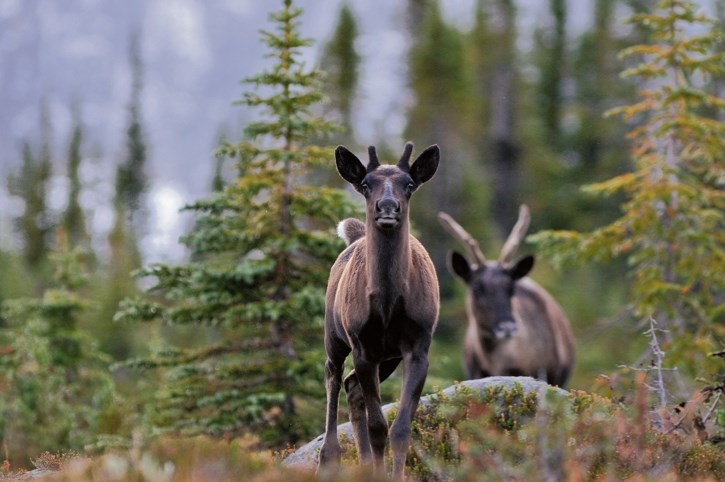A new plan to recover Alberta’s threatened woodland caribou populations calls for a large fenced-in caribou rearing facility to help boost the critically low numbers in the Little Smoky herd.
Alberta Environment and Parks released its draft plan for caribou recovery last week, which includes a draft range plan for the Little Smoky and A La Peche herds, based on recommendations of an independent mediator hired by the province.
Key recommendations in the report include providing permanent protection over the next five years of an additional 1.8 million hectares of caribou range in the Chinchaga, Bischto, Yates and Caribou Mountain ranges, for a grand total of 4.9 million hectares provincially.
The plan also recommends restoration of more than 10,000 seismic lines to caribou habitat in the Little Smoky and A La Peche caribou ranges, and construction of a fenced rearing facility covering about 100 square kilometres in the Little Smoky.
The wolf cull will continue into the foreseeable future.
Officials say caribou recovery in the Little Smoky and A La Peche ranges depends on reducing wolf predation rates so caribou populations can grow and stabilize, and restoring and conserving sufficient suitable habitat to support self-sustaining populations.
Stan Boutin, a professor of population ecology at the University of Alberta and chair of the Alberta Biodiversity Conservation Chair, said the government’s announcement signals some much-needed action on the Alberta caribou file, noting it’s a good day for caribou in Alberta.
Boutin said up to 50 female caribou would live in the rearing facility throughout the year, providing their young a safe place from predators at such a vulnerable stage of life.
There are about 80 caribou remaining in the Little Smoky herd, which has not increased in numbers despite an aggressive wolf cull, he said.
“Those calves would be protected until they’re one year old and then released back into the wild in the Little Smoky range. The idea is to give them full protection up to that age and avoid any losses to wolves and/or bears,” said Boutin.
“Once they’re released, our hope is their survival rates would be much akin to adult survival rates, rather than similar to calf survival rates, which have been incredibly low throughout the last little while.”
The goal is to have a captive rearing facility on the ground by the end of the year, though it might be a smaller pilot project in the beginning. The facility is to be funded by the government and industrial land users.
“It’s an optimistic timeline, but doable,” said Boutin.
Caribou are a threatened species federally and provincially. Under the federal Species At Risk Act, the federal government requires the Alberta government to manage 65 per cent of critical caribou habitat by October 2017.
Currently, there’s an estimated 3,500 caribou remaining in the province.
Many caribou herds are dwindling at an accelerating pace because of dramatic habitat changes and disturbance from logging, mining, oil and gas development, and recreation, with some herds at critically low numbers.
Other threats caribou face include climate change, wildfires and predators.
In some areas, wolves are preying heavily on caribou because they have easier access to traditional caribou range by trotting up man-made roads associated with industrial development.
More than 1,000 wolves have been shot dead from helicopters or poisoned with bait laced with strychnine since 2005 in areas in and adjacent to the Little Smoky and A La Peche caribou ranges.
The Alberta government will continue its cull on wolves, with plans to scale it back over time.
“If we get major success on calf survival and yearling survival, then one might be able to rely on that rather than this aggressive predator control each year,” said Boutin.
“We would potentially be able to wean ourselves 100 per cent off predator control, or do it in alternate years, or once every three years.”
The government’s plan for recovery says caribou habitat will be managed through the reduction of forest logging, modifications to how oil and gas resources are managed and coordinating industrial development to reduce total footprint on the landscape.
But the Alberta Wilderness Association says the big concern is the move to re-start forestry in the Little Smoky, which has been on hold for a year, and a lack of hard measurable limits on the footprint of oil and gas development.
“There are good statements, but it’s really hard to know if it’s going to be enough for caribou,” said Carolyn Campbell, the AWA’s conservation specialist.
“There’s a sense they’re still putting too much emphasis on scapegoating wildlife rather than protecting old forests from logging and establishing a clear footprint for the energy industry.”
The AWA is also critical of the captive rearing facility in the Little Smoky.
“It’s an awful step to legitimize essentially penning wild caribou in a zoo,” said Campbell.
“We are still relying on bizarre ways of manipulating and harming wildlife, both prey and predators, rather than tackling our responsibility to protect habitat there.”
Shannon Phillips, Minister of Environment and Parks, said the government inherited a policy logjam and a looming federal deadline to file a plan to recover caribou and manage critical habitat for the species throughout the province.
“Rather than admiring the problem, as had been done for two decades, our government took action,” she said in a statement. “We rolled up our sleeves and looked for solutions.”
The draft caribou range plan for Little Smoky and A La Peche is open for public input online until Aug. 5.




